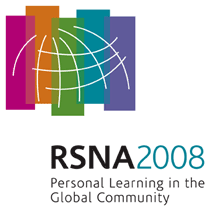
Abstract Archives of the RSNA, 2008
SSJ25-05
Combination Whole Pelvic Radiation Therapy (WPRT) + Cesium-131 Seed Implantation for Intermediate-to-High-Risk Prostate Cancer: Initial Experience and Parallel Comparison with Our WPRT + Palladium-103 Series
Scientific Papers
Presented on December 2, 2008
Presented as part of SSJ25: Radiation Oncology and Radiobiology (Genitourinary Malignancies)
Rajiv Sharma, Presenter: Nothing to Disclose
Cs-131 has the benefit of shorter half-life and higher initial dose rate, and has been shown to yield a homogenous dose distribution within the prostate. In this study, we report our experience using combination whole pelvic radiation therapy (WPRT) and Cs-131 seed implantation (SI) and compare the results to our previous experience with WPRT and Pd-103 SI.
All patients had a greater than 15% risk of pelvic lymphadenopathy (as defined by Partin tables) and received WPRT to a dose of 45Gy along with neoadjuvant, concurrent, and adjuvant androgen suppression therapy for 6-24 months. SI was performed using intra-operative planning and the prescription dose was 80-85Gy and 90Gy for Cs-131 and Pd-103, respectively. All patients underwent post-implant CT based dosimetry 3-4 weeks after SI. Biochemical failure was defined by the Phoenix criteria. Toxicty was graded according to the RTOG scale with “0” being no morbidity and “5” representing death.
13 patients were treated with Cs-131 and 56 patients were treated with Pd-103 SI . High risk disease (PSA>20, Gleason Score =8, or >50% cores positive) was present in 7 Cs-131 and 20 Pd-103 patients. For the Cs-131 and Pd-103 groups, respectively, the median values were as follows: Prostate D90 was 64.8Gy (36.6-78.7Gy) vs. 58.4Gy (39.3-123.8Gy) and CT/US ratio of prostate volume was 1.13 (0.89-1.75) vs. 1.33 (0.96-2.03). Toxicity for the Cs-131 and Pd-103 groups, respectively, were as follows: Acute grade 2 genitourinary toxicity occurred in 38.5% vs. 27.3%, grade 3 urinary retention developed in 7.7% vs. and 8.9% (all required TURP), and long-term grade 1 hematuria occurred in 0% and 3.6%. No =Grade 2 acute or long-term gastrointestinal morbidity was noted in either group. Toxicity did not correlate with higher D90 or with the timing of SI.At a median follow-up of 8 months (1-12mo) and 45 months (3-90 mo), the freedom from biochemical failure (FFBF) rate was 100% and 94.6% for the Cs-131 and Pd-103 groups, respectively. Disease specific survival was 100% for both groups and overall survival was 100% and 89.3% for the Cs-131 and Pd-103 groups, respectively. In the high-risk cohort, one failure occurred after treatment with Pd-103 combination therapy.
The combination of Cs-131 and WPRT along with androgen suppression for intermediate and high-risk prostate cancer has comparable rates of acute toxicity to combination therapy with Pd-103 SI. Continued follow-up of the Cs-131 group is needed to define the long-term biochemical failure rate as compared to the promising results seen with Pd-103 combination therapy.
Sharma, R,
Combination Whole Pelvic Radiation Therapy (WPRT) + Cesium-131 Seed Implantation for Intermediate-to-High-Risk Prostate Cancer: Initial Experience and Parallel Comparison with Our WPRT + Palladium-103 Series. Radiological Society of North America 2008 Scientific Assembly and Annual Meeting, February 18 - February 20, 2008 ,Chicago IL.
http://archive.rsna.org/2008/7001849.html

